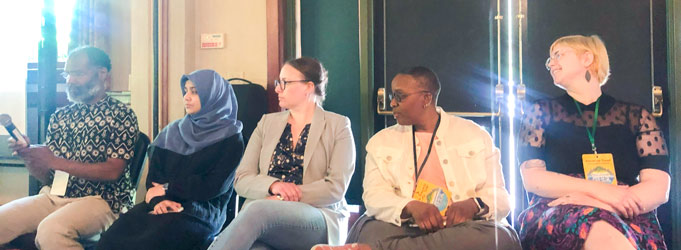Inclusive Integration in the Pacific Northwest: Reflections on the 33rd PNW-SETAC conference
Heidi Siegelbaum, Washington State University
This article was republished from the SETAC Pacific Northwest Chapter website with permission.
Phrases like “storied knowledge,” “toxic geography,” “fancy dirt” and “children born pre-polluted” provided critical context to this year’s SETAC Pacific Northwest Chapter conference. The three-day conference opened on a Monday morning with Sarah Marie Wiebe from the University of Victoria, who spoke passionately about seeking the “truth” via monitoring and inclusion.
“See, know and understand” was her message about the importance of how state actors have to engage their public. Community-engaged research involves a relational approach that involves listening, humility, reciprocity and engaging the senses. Wiebe’s book “Everyday Exposure” is a useful outline of what frontline communities experience versus the anonymity of the issues for many others. “Everyday Exposure” also cites Rob Nixon’s application of “slow violence,” the unfolding of illness, disempowerment and highly localized, disproportionate impacts of industrial chemical manufacturing. The communities themselves declared a state of emergency. What follows, however, is an encouraging story that is still being fought. That story is being told.

On the second day of the conference, participants heard from a panel regarding environmental justice:
- Michael Pouncil, Portland Harbor Community Advisory Group
- Samreen Siddiqui, King County Department of Natural Resources and Parks
- Janet Niessner, Confederated Tribes of Coos, Lower Umpqua and Siuslaw Indians
- Nicole Browning, Oregon Health & Science University-Portland State University School of Public Health
- Tammi Fierro, Portland State University
- Allie Tissot, Portland State University
Poucil quoted liberally from Nixon’s stunning book. A few notes from this discussion:
- There is a golden handcuff tradeoff – there’s some economic stability but you’ll pay with your health and, possibly, your life
- Environmental justice has distributive implications or the uneven distribution of harm
- There is a decline in the number of males born in First Nation communities because of endocrine-disrupting chemicals
- Heat, sound, vibrations and smell are all a part of the slow violence
- There is no consistent policing in rural areas
- There is a lack of representative leadership
- There is a need for better waste management (and production) of medical plastics
So what now? A few ideas discussed were to:
- Collect fees as part of enforcement actions, which should be returned to the community and not placed in a general fund
- Establish a program for community compensation
- Remove barriers to participation and meaningful engagement
- Hold a conference to identify problems in the community
- Work to advance environmental justice embeddedness
- Cultivate and practice more effective communication about toxics
Other snippets from the conference
The following points caught our eyes. This is not a comprehensive list, and we are grateful for all the compelling conversations, including ones not mentioned here:
- Commercial laundries in the Snohomish Basin Washington are a major source of PBDEs causing mortality in Juvenile Chinook Salmon.
- 30-40% mortality can cause extinction.
- Over 10 years, we added 2,700 miles of new roads and 10,000 fish barriers.
- Most of the issues with salmon were related to cardio-respiratory problems.
- PAH exposure to juvenile salmon reduces growth, increases disease susceptibility, alters behavior and increases mortality, low dietary absorption efficiencies whereby contaminants go straight into the food web.
- Pharma products are designed to be bioreactive in humans, so receptor targets are highly conserved.
- Legacy and CECs are being found in edible seaweed, a widely foraged and consumed marine algae and plants.
- High-performance bioretention mix, now dubbed “fancy dirt,” is highly effective at remediating toxics.
- Traditional ecological risk assessment is based on the so-called Red Book, a human health-oriented tome. There is no mention of uncertainty, which should be the first thing you talk about- the approach does not work with multiple stressors.
- Plastic bottles take 450 years to break down.
- Nano-plastics are 1,000 times smaller than a grain of sand. We need evidence, but we don’t currently have the analytical tools.
- Bottle caps can release up to 1 million particles.
- Packaging is the #1 source of nano and microplastics.
- Agriculture practices use 12 million tons of plastic each year, compelling us to look at terrestrial sources in addition to marine.
- Adverse effects from plastics include (1) food dilution; (2) oxidative stress; and (3) changes in behavior.
- Noted plastic-related policy needs include development and application of a health-based framework for informing regulatory action related to exposure to microplastics. The policy framework must also address the effects of plastic incorporated into natural elements like rocks, called “pyroplastics.” The “matrix,” air, water, biota and sediment, calls for addressing scale, a targeted range of plastic sizes and forward planning for sample preparation, identification and analysis. In the case of nanoplastics, surface chemistry is a huge driver…and let’s not forget that tire particles are themselves, plastic.
We are grateful for the heart, passion, excellence and truth-seeking of our regional Pacific Northwest SETAC colleagues bring to making our homes more resilient and to strive for collaborative solutions to these vexing issues.
Author's contact: [email protected]
